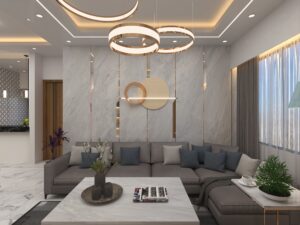What is the standard way of color selection in interior design???

Choosing the right color palette is a fundamental aspect of interior design that significantly influences the ambiance and functionality of a space. Colors can evoke emotions, create illusions of space, and reflect personal style. Understanding the standard methods of color selection is essential for achieving harmonious and aesthetically pleasing interiors. Professionals from the best interior design in Dhaka, Bangladesh, including the employ systematic approaches to color selection to create stunning and cohesive spaces. This article explores the standard ways of color selection in interior design.
1. Understanding Color Theory
At the core of effective color selection lies a solid understanding of color theory. This involves comprehending the color wheel, which showcases the relationship between primary, secondary, and tertiary colors.
- Primary Colors: Red, blue, and yellow form the basis of all other colors.
- Secondary Colors: Mixing primary colors yields green, orange, and purple.
- Tertiary Colors: A combination of primary and secondary colors results in hues like red-orange and blue-green.
Designers from the best interior company in Dhaka utilize the color wheel to create harmonious color schemes that enhance the visual appeal and mood of a space.
2. Employing Color Schemes
Standard color schemes guide designers in selecting compatible colors. Common schemes include:
- Monochromatic: Uses variations in lightness and saturation of a single color for a clean and elegant look.
- Analogous: Combines colors that are next to each other on the color wheel, creating serene and comfortable designs.
- Complementary: Involves colors opposite each other on the color wheel, offering high contrast and vibrant aesthetics.
- Triadic: Utilizes three colors evenly spaced around the color wheel, resulting in a balanced and dynamic palette.
The top 10 interior companies in Dhaka, Bangladesh often choose appropriate color schemes based on the function and desired mood of the space.
3. Considering Color Psychology
Colors have psychological effects that can influence emotions and behaviors:
- Warm Colors (Red, Orange, Yellow): Evoke energy, warmth, and comfort but can also signify urgency.
- Cool Colors (Blue, Green, Purple): Convey calmness, relaxation, and tranquility.
- Neutral Colors (White, Gray, Brown): Provide balance and serve as background hues that complement other colors.
Expert designers from the best interior firm in Dhaka, Bangladesh consider these psychological impacts to ensure the space serves its intended purpose effectively.

4. Assessing Lighting Conditions
Lighting profoundly affects how colors appear:
- Natural Light: Reveals the truest color tones; variations occur throughout the day.
- Artificial Light: Different bulbs (incandescent, fluorescent, LED) can alter color perception.
Professionals from the best interior design in Dhaka, Bangladesh evaluate lighting conditions meticulously to select colors that maintain their desired appearance under various lighting scenarios.
5. Reflecting on Space and Size
Colors can manipulate the perception of space:
- Light Colors: Make rooms feel larger and more open.
- Dark Colors: Create a cozy and intimate atmosphere but can make spaces appear smaller.
The best interior company in Dhaka strategically uses colors to enhance or alter spatial perceptions according to client preferences and architectural constraints.
6. Incorporating Existing Elements
Existing furniture, flooring, and architectural features influence color selection:
- Harmony: Ensuring new colors complement existing elements for a cohesive look.
- Focal Points: Using color to highlight architectural features or artwork.
Designers from the top 10 interior companies in Dhaka, Bangladesh conduct thorough assessments of existing elements to integrate new color schemes seamlessly.
7. Sampling and Testing
Before finalizing colors, sampling is crucial:
- Swatches: Applying paint samples on walls to observe how colors look in different lights and times.
- Materials: Testing fabrics and materials alongside paint samples to ensure compatibility.
This methodical approach, practiced by the best interior firm in Dhaka, Bangladesh, minimizes errors and ensures client satisfaction.

8. Staying Updated with Trends
While personal preference is paramount, awareness of current design trends adds modernity:
- Trend Research: Keeping abreast of popular and emerging color trends.
- Timelessness: Balancing trendy choices with classic colors to ensure longevity.
The best interior design in Dhaka, Bangladesh blends contemporary trends with timeless design principles to create enduring and stylish interiors.
Conclusion
Selecting the right colors in interior design is a comprehensive process that combines art and science. It involves understanding color theory, psychological impacts, lighting, spatial dynamics, and existing design elements. Professionals from the best interior company in Dhaka and the top 10 interior companies in Dhaka, Bangladesh, apply these standard methodologies to craft spaces that are both functional and aesthetically pleasing. Whether embarking on a new project or revamping an existing space, considering these principles can help achieve a harmonious and inviting interior that reflects personal style and meets functional needs.
Engaging with experts from the best interior firm in Dhaka, Bangladesh ensures access to skilled professionals who can guide you through the color selection process, tailoring choices to your specific preferences and requirements. Their expertise and experience are invaluable in creating spaces that are not only beautiful but also resonate with comfort and individuality.













